Observed Multi-Timescale Differences between Summertime Near-Surface Equivalent Temperature and Temperature for China and Their Linkage with Global Sea Surface Temperatures
Abstract
1. Introduction
2. Data and Methods
2.1. Observational and Reanalysis Datasets
2.2. Calculation of Equivalent Temperature
2.3. Ensemble Empirical Mode Decomposition
3. Results
3.1. Leading Modes of T and Te at Different Timescales
3.2. The Role of T and LH Terms in Determining the Variations of Te
3.3. Similarities and Differences in the Linkage between SST and the Leading Mode of T and Te
4. Conclusions and Discussion
Supplementary Materials
Author Contributions
Funding
Acknowledgments
Conflicts of Interest
References
- IPCC. Climate Change 2007: The Physical Science Basis; Cambridge University Press: Cambridge, UK, 2007.
- IPCC. Climate Change 2013: The Physical Science Basis; Cambridge University Press: Cambridge, UK, 2013.
- IPCC. Climate Change 2018: Global Warming of 1.5°C. 2018; in press. Available online: https://www.ipcc.ch/sr15/ (accessed on 3 August 2019).
- IPCC. Managing the Risks of Extreme Events and Disasters to Advance Climate Change Adaptation; Cambridge University Press: Cambridge, UK, 2012.
- Qian, C.; Zhang, X.; Li, Z. Linear trends in temperature extremes in China, with an emphasis on non-Gaussian and serially dependent characteristics. Clim. Dyn. 2018, 53, 533–550. [Google Scholar] [CrossRef]
- Pielke Sr, R.A.; Davey, C.; Morgan, J. Assessing “global warming” with surface heat content. Eos Trans. Am. Geophys. Union 2004, 85, 210–211. [Google Scholar] [CrossRef]
- Davey, C.A.; Pielke, R.A.; Gallo, K.P. Differences between near-surface equivalent temperature and temperature trends for the Eastern United States: Equivalent temperature as an alternative measure of heat content. Glob. Planet. Chang. 2006, 54, 19–32. [Google Scholar] [CrossRef]
- Fall, S.; Diffenbaugh, N.S.; Niyogi, D.; Pielke Sr, R.A.; Rochon, G. Temperature and equivalent temperature over the United States (1979–2005). Int. J. Climatol. 2010, 30, 2045–2054. [Google Scholar] [CrossRef]
- Sherwood, S.C.; Huber, M. An adaptability limit to climate change due to heat stress. Proc. Natl. Acad. Sci. USA 2010, 107, 9552–9555. [Google Scholar] [CrossRef] [PubMed]
- Dunne, J.P.; Stouffer, R.J.; John, J.G. Reductions in labour capacity from heat stress under climate warming. Nat. Clim. Chang. 2013, 3, 563–566. [Google Scholar] [CrossRef]
- Knutson, T.R.; Ploshay, J.J. Detection of anthropogenic influence on a summertime heat stress index. Clim. Chang. 2016, 138, 25–39. [Google Scholar] [CrossRef]
- Pal, J.S.; Eltahir, E.A.B. Future temperature in southwest Asia projected to exceed a threshold for human adaptability. Nat. Clim. Chang. 2016, 6, 197–200. [Google Scholar] [CrossRef]
- Findell, K.L.; Berg, A.; Gentine, P.; Krasting, J.P.; Lintner, B.R.; Malyshev, S.; Santanello, J.A.; Shevliakova, E. The impact of anthropogenic land use and land cover change on regional climate extremes. Nat. Commun. 2017, 8, 989. [Google Scholar] [CrossRef] [PubMed]
- Karl, T.R.; Knight, R.W. The 1995 Chicago heat wave: How likely is a recurrence? Bull. Am. Meteorol. Soc. 1997, 78, 1107–1120. [Google Scholar] [CrossRef]
- Grumm, R.H. The central European and Russian heat event of July–August 2010. Bull. Am. Meteorol. Soc. 2011, 92, 1285–1296. [Google Scholar] [CrossRef]
- Kang, S.; Eltahir, E.A.B. North china plain threatened by deadly heatwaves due to climate change and irrigation. Nat. Commun. 2018, 9, 2894. [Google Scholar] [CrossRef] [PubMed]
- Younger, K.; Mahmood, R.; Goodrich, G.; Pielke, R.A.; Durkee, J. Mesoscale surface equivalent temperature (te) for east central USA. Theor. Appl. Climatol. 2019, 136, 65–75. [Google Scholar] [CrossRef]
- Yin, H.; Sun, Y.; Wan, H.; Zhang, X.; Lu, C. Detection of anthropogenic influence on the intensity of extreme temperatures in China. Int. J. Climatol. 2017, 37, 1229–1237. [Google Scholar] [CrossRef]
- Sun, Y.; Zhang, X.; Zwiers, F.W.; Song, L.; Wan, H.; Hu, T.; Yin, H.; Ren, G. Rapid increase in the risk of extreme summer heat in Eastern China. Nat. Clim. Chang. 2014, 4, 1082–1085. [Google Scholar] [CrossRef]
- Qian, C. On trend estimation and significance testing for non-Gaussian and serially dependent data: Quantifying the urbanization effect on trends in hot extremes in the megacity of Shanghai. Clim. Dyn. 2016, 47, 329–344. [Google Scholar] [CrossRef]
- Ren, G.; Zhou, Y. Urbanization effect on trends of extreme temperature indices of national stations over mainland China, 1961–2008. J. Clim. 2014, 27, 2340–2360. [Google Scholar] [CrossRef]
- Qian, C.; Yan, Z.; Cao, L.; Li, Z. Climatic changes in the twenty-four solar terms based on temperature observations back to 1873. Clim. Environ. Res. 2018, 23, 670–682. (In Chinese) [Google Scholar] [CrossRef]
- Wu, Z.; Jiang, Z.; Li, J.; Zhong, S.; Wang, L. Possible association of the western Tibetan Plateau snow cover with the decadal to interdecadal variations of northern China heatwave frequency. Clim. Dyn. 2012, 39, 2393–2402. [Google Scholar] [CrossRef]
- Hu, K.; Huang, G.; Huang, R. The impact of tropical Indian Ocean variability on summer surface air temperature in China. J. Clim. 2011, 24, 5365–5377. [Google Scholar] [CrossRef]
- Wu, R.; Yang, S.; Liu, S.; Sun, L.; Lian, Y.; Gao, Z. Changes in the relationship between Northeast China summer temperature and ENSO. J. Geophys. Res. Atmos. 2010, 115, D21107. [Google Scholar] [CrossRef]
- Chen, Y.; Zhai, P. Revisiting summertime hot extremes in China during 1961–2015: Overlooked compound extremes and significant changes. Geophys. Res. Lett. 2017, 44, 5096–5103. [Google Scholar] [CrossRef]
- Zhang, J.; Sun, F.; Xu, J.; Chen, Y.; Sang, Y.-F.; Liu, C. Dependence of trends in and sensitivity of drought over china (1961–2013) on potential evaporation model. Geophys. Res. Lett. 2016, 43, 206–213. [Google Scholar] [CrossRef]
- Chai, R.; Sun, S.; Chen, H.; Zhou, S. Changes in reference evapotranspiration over china during 1960–2012: Attributions and relationships with atmospheric circulation. Hydrol. Process. 2018, 32, 3032–3048. [Google Scholar] [CrossRef]
- Pielke Sr, R.A. Influence of the spatial distribution of vegetation and soils on the prediction of cumulus Convective rainfall. Rev. Geophys. 2001, 39, 151–177. [Google Scholar] [CrossRef]
- Henderson-Sellers, B. A new formula for latent heat of vaporization of water as a function of temperature. Q. J. R. Meteorol. Soc. 1984, 110, 1186–1190. [Google Scholar] [CrossRef]
- Wu, Z.; Huang, N.E. Ensemble empirical mode decomposition: A noise-assisted data analysis method. Adv. Adapt. Data Anal. 2009, 1, 1–41. [Google Scholar] [CrossRef]
- Huang, N.E.; Shen, Z.; Long, S.R.; Wu, M.C.; Shih, H.H.; Zheng, Q.; Yen, N.-C.; Tung, C.C.; Liu, H.H. The empirical mode decomposition and the Hilbert spectrum for nonlinear and non-stationary time series analysis. Proc. R. Soc. Lond. Ser. A Math. Phys. Eng. Sci. 1998, 454, 903–995. [Google Scholar] [CrossRef]
- Qian, C.; Fu, C.; Wu, Z.; Yan, Z. On the secular change of spring onset at Stockholm. Geophys. Res. Lett. 2009, 36, L12706. [Google Scholar] [CrossRef]
- Franzke, C. Nonlinear trends, long-range dependence, and climate noise properties of surface temperature. J. Clim. 2012, 25, 4172–4183. [Google Scholar] [CrossRef]
- Kim, T.; Shin, J.-Y.; Kim, S.; Heo, J.-H. Identification of relationships between climate indices and long-term precipitation in south korea using ensemble empirical mode decomposition. J. Hydrol. 2018, 557, 726–739. [Google Scholar] [CrossRef]
- Wu, Z.; Huang Norden, E. A study of the characteristics of white noise using the empirical mode decomposition method. Proc. R. Soc. Lond. Ser. A Math. Phys. Eng. Sci. 2004, 460, 1597–1611. [Google Scholar] [CrossRef]
- Wilks, D.S. Chapter 12—Principal component (eof) analysis. In International Geophysics; Wilks, D.S., Ed.; Academic Press: Cambridge, MA, USA, 2011; Volume 100, pp. 519–562. [Google Scholar]
- Bretherton, C.S.; Widmann, M.; Dymnikov, V.P.; Wallace, J.M.; Bladé, I. The effective number of spatial degrees of freedom of a time-varying field. J. Clim. 1999, 12, 1990–2009. [Google Scholar] [CrossRef]
- Committee of Chinese National Assessment Report on Climate Change. Third China’s National Assessment Report on Climate Change; China Science Press: Beijing, China, 2015. (In Chinese) [Google Scholar]
- Wu, R.; Yang, S.; Liu, S.; Sun, L.; Lian, Y.; Gao, Z. Northeast China summer temperature and North Atlantic SST. J. Geophys. Res. Atmos. 2011, 116, D16116. [Google Scholar] [CrossRef]
- Wang, J.; Yang, B.A.O.; Ljungqvist, F.C.; Zhao, Y.A.N. The relationship between the Atlantic Multidecadal Oscillation and temperature variability in China during the last millennium. J. Quat. Sci. 2013, 28, 653–658. [Google Scholar] [CrossRef]
- Wang, B.; Wu, R.; Fu, X. Pacific–East Asian teleconnection: How does ENSO affect East Asian climate? J. Clim. 2000, 13, 1517–1536. [Google Scholar] [CrossRef]
- Li, J.; Chen, Y.D.; Gan, T.Y.; Lau, N.-C. Elevated increases in human-perceived temperature under climate warming. Nat. Clim. Chang. 2018, 8, 43–47. [Google Scholar] [CrossRef]

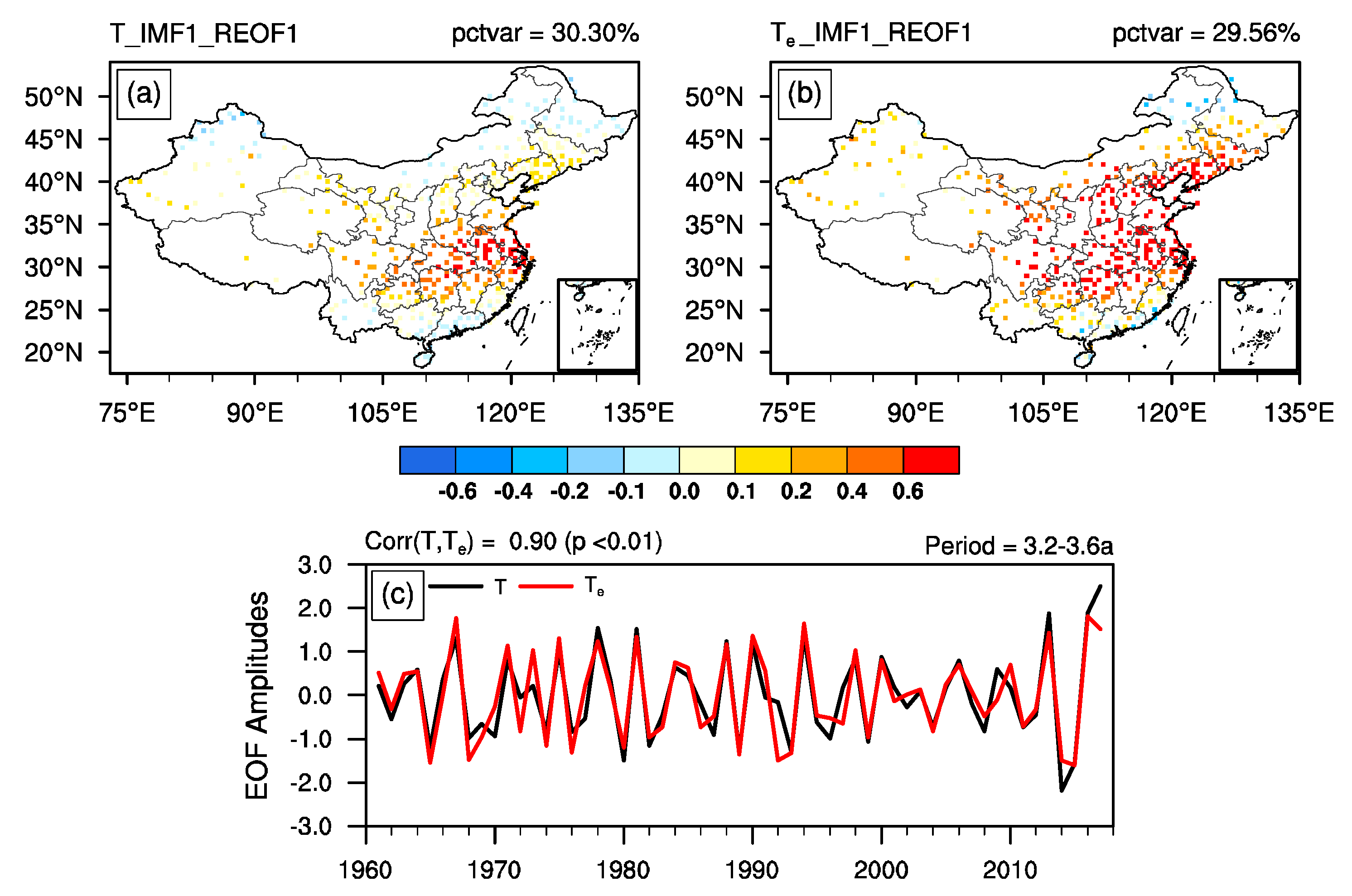
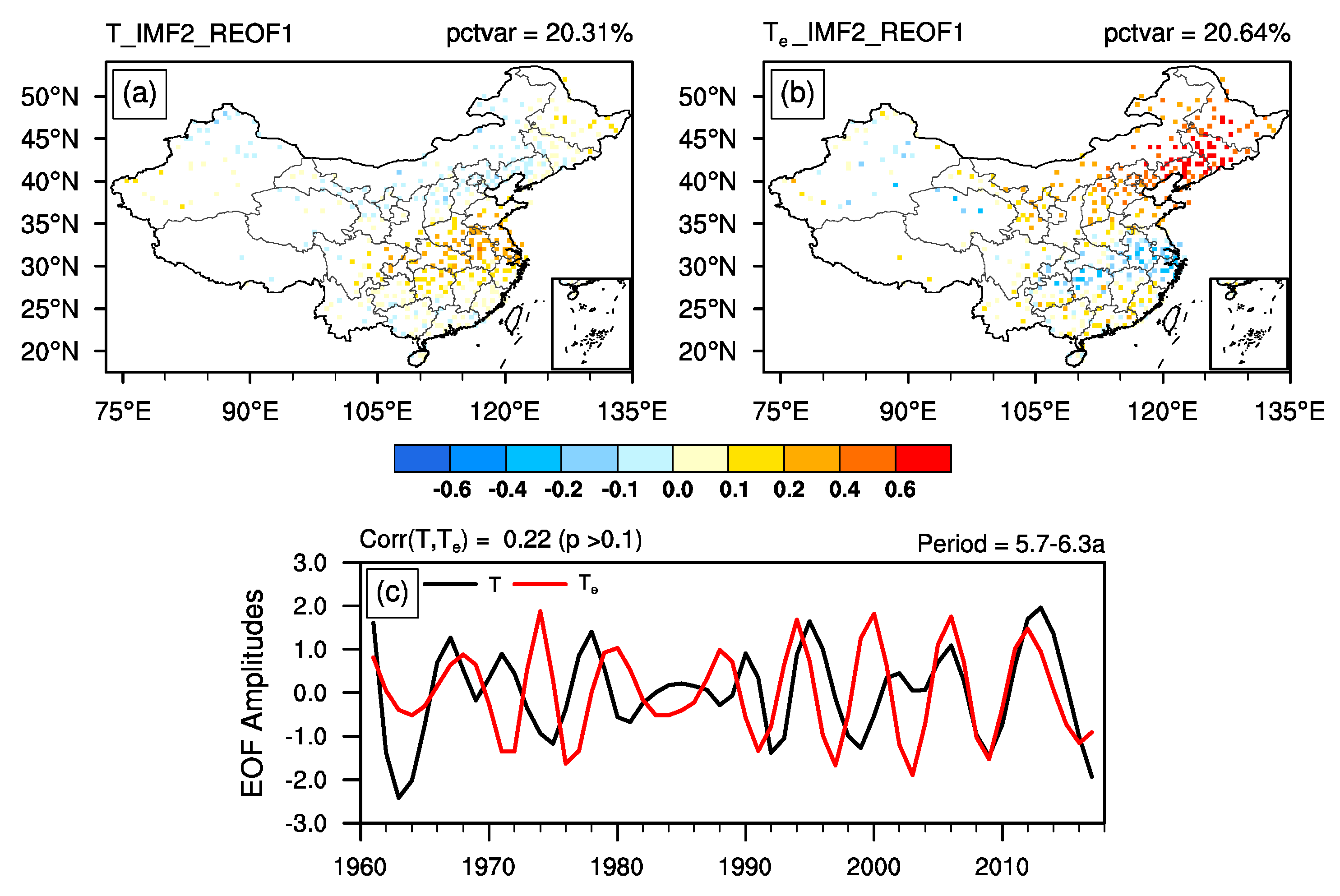
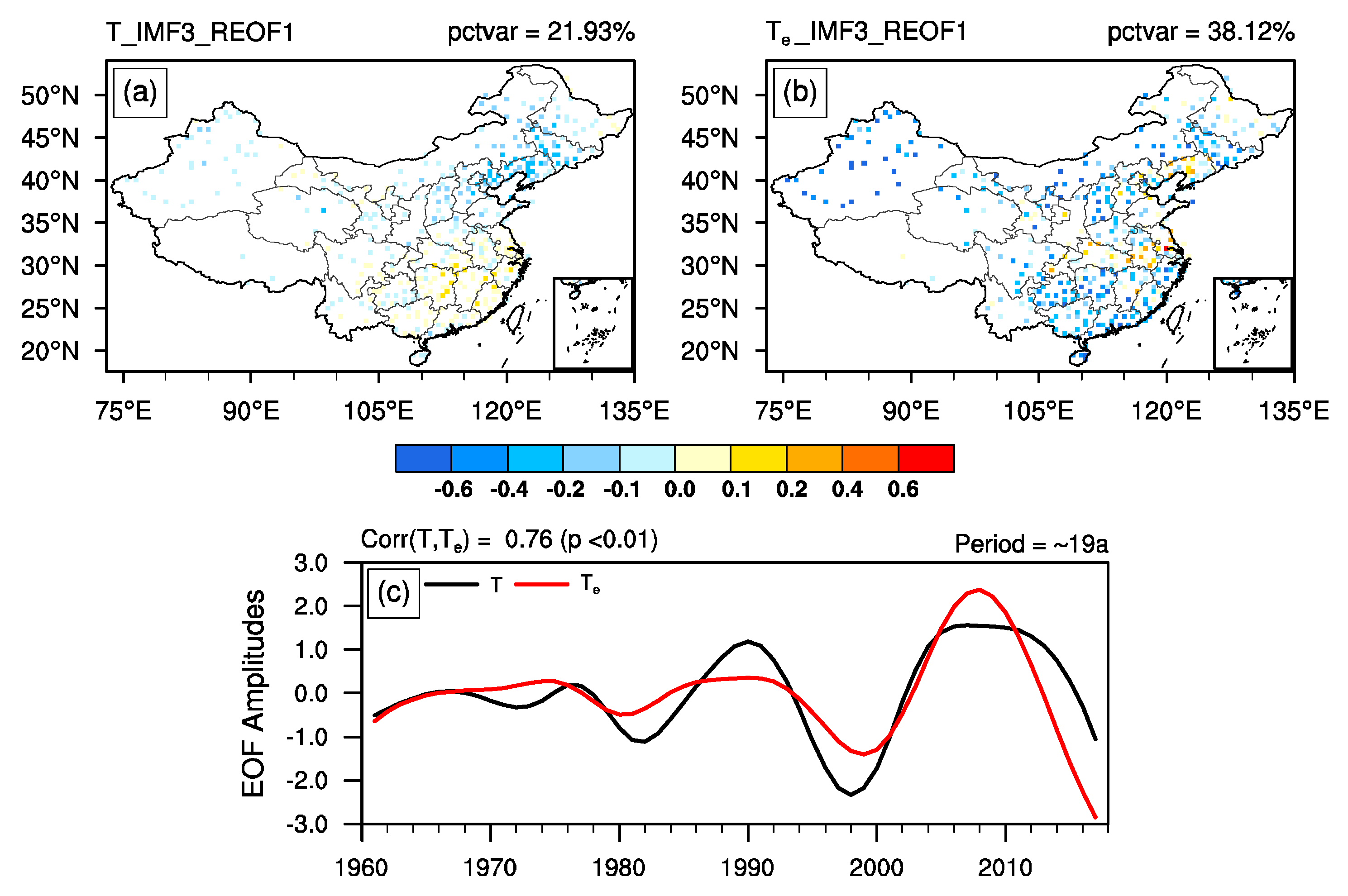
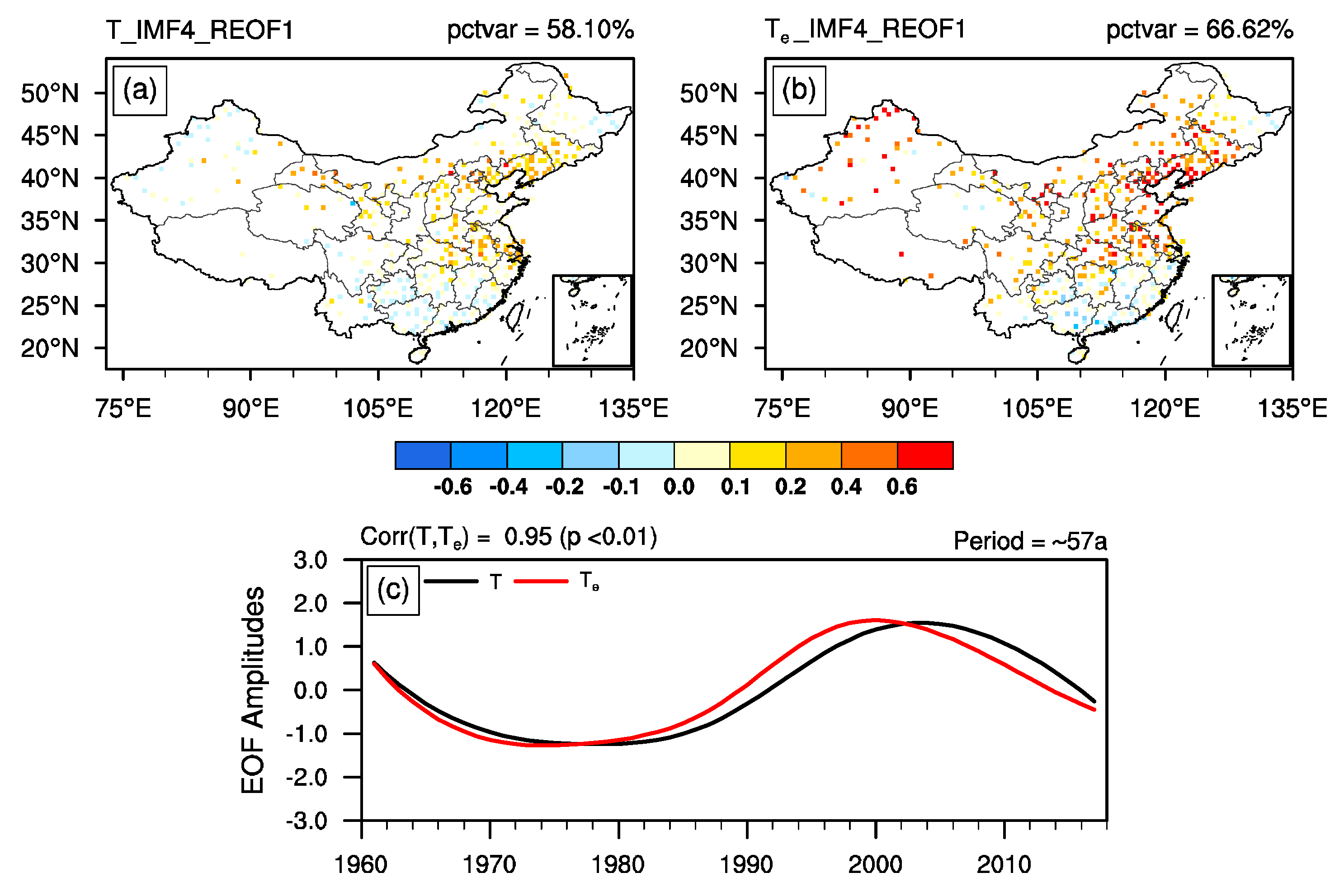
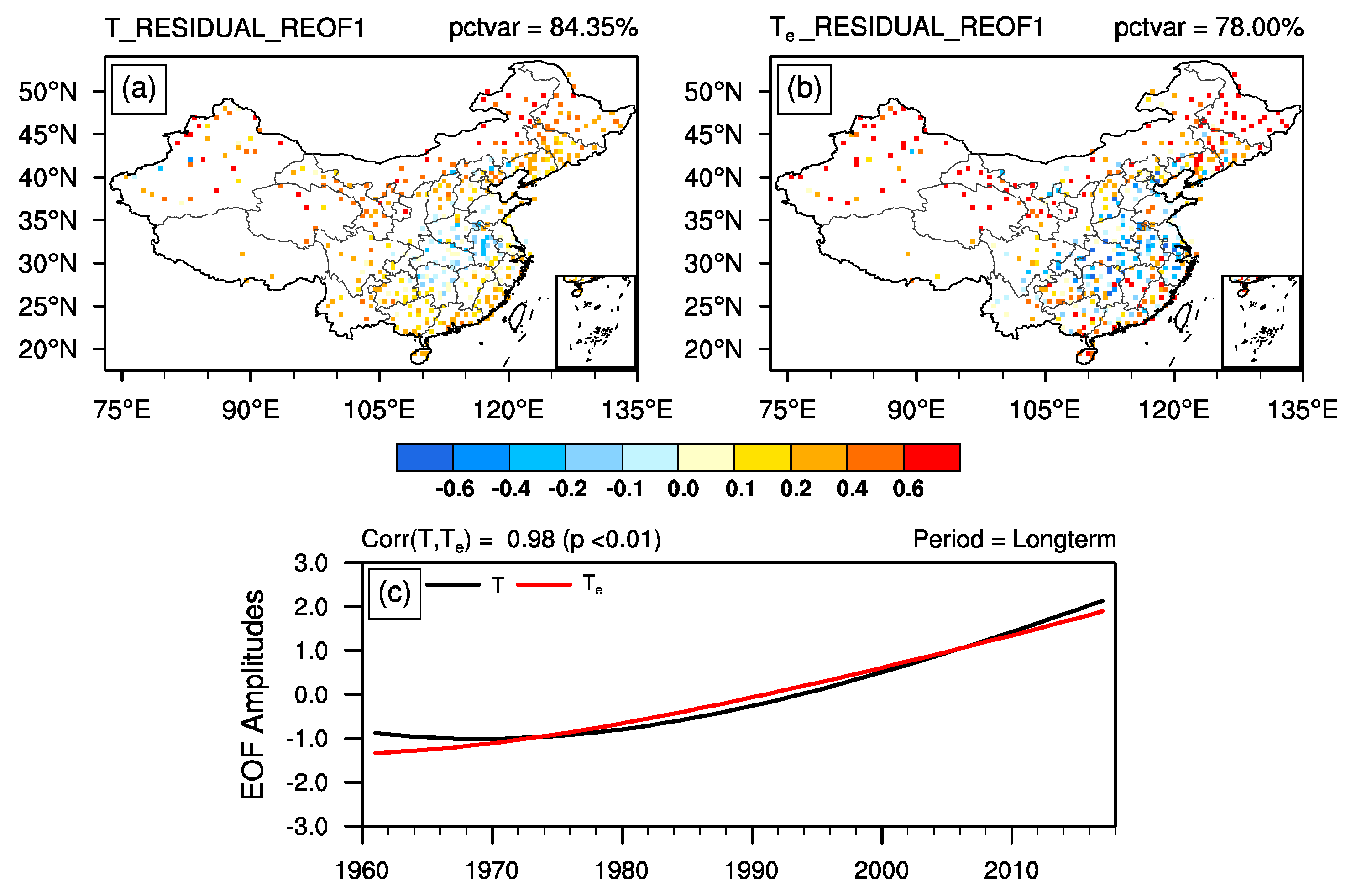
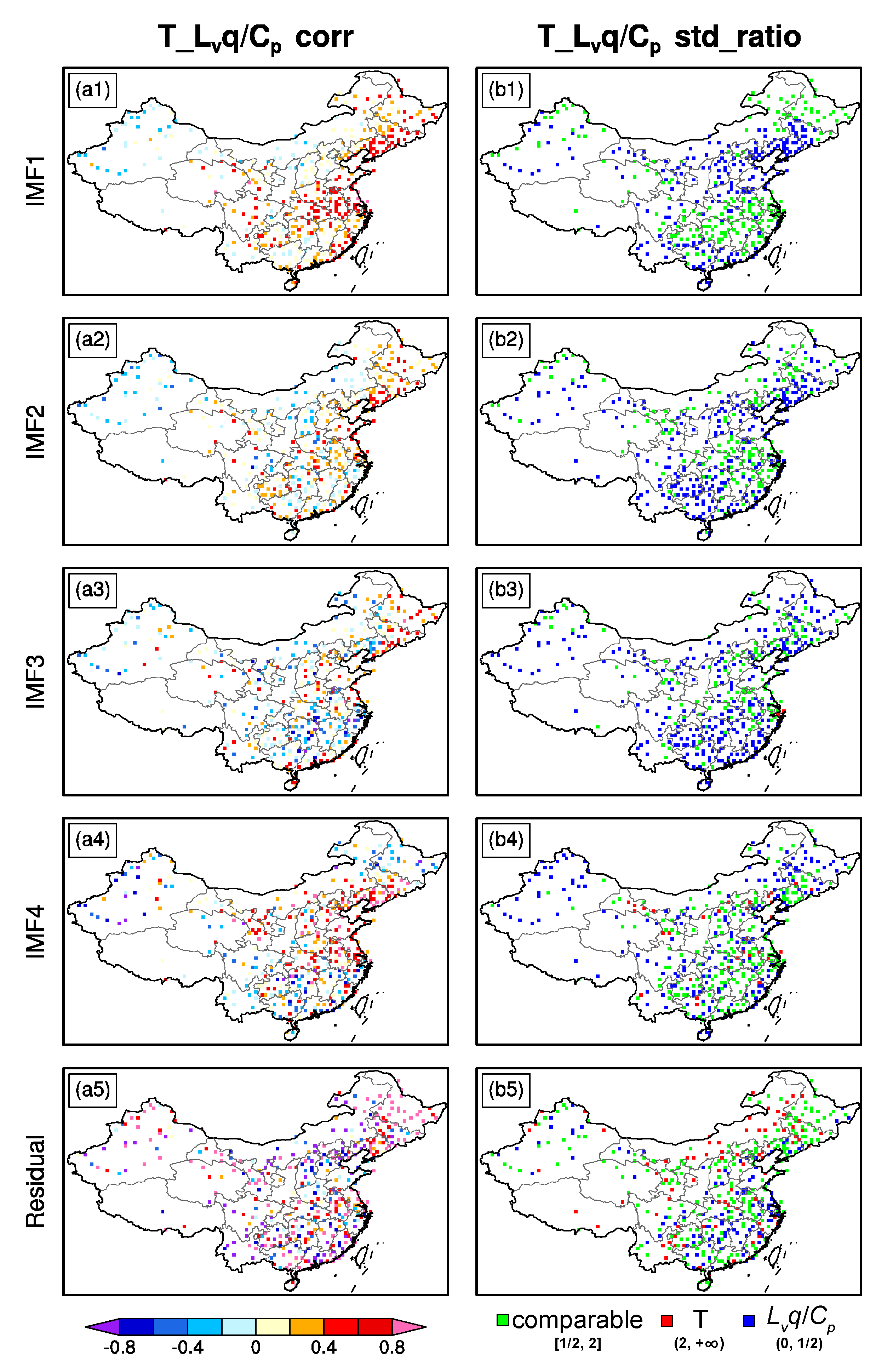

| EEMD-REOF Principal Components | ||||||||
|---|---|---|---|---|---|---|---|---|
| SST Indices | T-IMF1 | Te-IMF1 | T-IMF2 | Te-IMF2 | T-IMF3 | Te-IMF3 | T-IMF4 | Te-IMF4 |
| Niño 3.4 | −0.30 * | −0.43 * | 0.06 | −0.31 * | 0.02 | −0.11 | −0.01 | 0.01 |
| NAT | −0.03 | −0.10 | −0.03 | −0.23 | −0.03 | −0.20 | −0.37 | −0.33 |
| PDO | −0.17 | −0.28 | −0.04 | −0.19 | −0.13 | −0.21 | −0.08 | 0.05 |
| AMO | 0.06 | 0.12 | 0.01 | 0.09 | 0.17 | 0.01 | 0.67 * | 0.59 * |
© 2019 by the authors. Licensee MDPI, Basel, Switzerland. This article is an open access article distributed under the terms and conditions of the Creative Commons Attribution (CC BY) license (http://creativecommons.org/licenses/by/4.0/).
Share and Cite
Li, J.; Li, X.; Li, X.; Chen, L.; Jin, L. Observed Multi-Timescale Differences between Summertime Near-Surface Equivalent Temperature and Temperature for China and Their Linkage with Global Sea Surface Temperatures. Atmosphere 2019, 10, 447. https://doi.org/10.3390/atmos10080447
Li J, Li X, Li X, Chen L, Jin L. Observed Multi-Timescale Differences between Summertime Near-Surface Equivalent Temperature and Temperature for China and Their Linkage with Global Sea Surface Temperatures. Atmosphere. 2019; 10(8):447. https://doi.org/10.3390/atmos10080447
Chicago/Turabian StyleLi, Jingping, Xiao Li, Xing Li, Lian Chen, and Likun Jin. 2019. "Observed Multi-Timescale Differences between Summertime Near-Surface Equivalent Temperature and Temperature for China and Their Linkage with Global Sea Surface Temperatures" Atmosphere 10, no. 8: 447. https://doi.org/10.3390/atmos10080447
APA StyleLi, J., Li, X., Li, X., Chen, L., & Jin, L. (2019). Observed Multi-Timescale Differences between Summertime Near-Surface Equivalent Temperature and Temperature for China and Their Linkage with Global Sea Surface Temperatures. Atmosphere, 10(8), 447. https://doi.org/10.3390/atmos10080447





